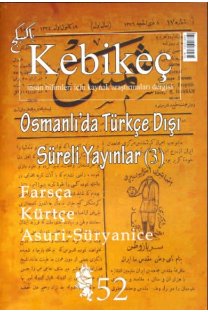Asur-İmparatorluğu'nda Gündelik Hayat Üzerine: Urad-Gula'nın Mektubu K.4267
Asur İmparatorluğu'nda gündelik hayat ile ilgili yeni bir okumayla bir Yeni-Asur mektubunu inceleyen bu çalışma, konu ile ilgili araştırmalar için bir örnek sunmayı hedeflemiştir. K.4267 envanter numaralı Yeni-Asur mektubu tanıtılmakta, transkripsiyonu ve çevirisi verildikten sonra, mektubun yazarının Asur İmparatorluğu dönemi gündelik hayatla ilgili öne çıkardığı öğeler tartışılmaktadır.
On Daily Life in the Assyrian Empire: Urad-Gula's Letter K.4267
This study provides a reading of daily life in the Assyrian Empire based on a Neo-Assyrian letter and seeks to establish a precedent for future research on the topic. The introduction to, the transliteration and translation of Neo-Assyrian letter K.4267 is followed by the discussion of various elements of daily life in the Assyrian Empire as emphasized by the author of the letter
___
Fahd, Toufic. La divination arabe: Études religieuses, sociologiques et folkloriques sur le milieu natif de l'Islam. Leiden: Brill. 1966.Galil, Gershon. The Lower Stratum Families in the Neo-Assyrian Period. Leiden ve Boston: Brill. 2007.
Gökçek, L. Gürkan. Asurlular. Ankara: Bilgin Kültür Sanat Yayınları. 2015.
Gurney, Oliver R. ve Jacob J. Finkelstein. The Sultantepe Tablets I. Londra: The British Institute of Archaeology at Ankara. 1957.
Gurney, Oliver R. ve Peter Hulin. The Sultantepe Tablets II. Londra: The British Institute of Archaeology at Ankara, 1964.
Hämeen-Anttila, Jaakko. "Arabian Prophecy" Martti Nissinen, ed. Prophecy in its Ancient Near Eastern Context: Mesopotamian, Biblical, and Arabian Perspectives. Atlanta: Society of Biblical Literature (2000): 115-146.
Hirst, Jacqueline ve Geeta Pandey. Growing up in Hinduism. Londra: Longman, 1990.
Hurowitz, Victor Avigdor. "ABL 1285 and the Hebrew Bible. Literary Topoi in Urad-Gula's Letter of Petition to Assurbanipal" State Archives of Assyria Bulletin 7 (1993): 9-17.
Ito, Sanae. "A Letter from Assurbanipal to Enlil-b?ni and the Citizens of Nippur" Fragmentations 4 (2013): 19-34.
Jiménez, Enrique, ve Selim F. Adalı, "The 'Prostration Hemerology' Revisited: An Everyman's Manual at the King's Court" Zeitschrift für Assyriologie 105 (Yayınlanacak).
Kanitkar, V. P. Hemant ve W. Owen Cole. Teach Yourself Hinduism. Londra ve Chicago: Hodder ve NTC/Contemporary Publishing. 1995.
Köroğlu, Kemalettin. Eski Mezopotamya Tarihi. Başlangıcından Perslere Kadar. İstanbul: İletişim Ya- yınları. 2006.
Livingstone, Alasdair. "Ashurbanipal: Literate or Not?" Zeitschrift für Assyriologie 97 (2007): 98-118.
Livingstone, Alasdair. Hemerologies of Assyrian and Babylonian Scholars. Bethesda, Maryland: CDL Press. 2013.
Luukko, Mikko. "On Standardisation and Variation in the Introductory Formulae of Neo- Assyrian Letters" Iraq 74 (2012): 97-115.
Nissinen, Martti. References to Prophecy in Neo-Assyrian Sources. Helsinki: Helsinki University Press. 1998.
Oppenheim, A. Leo ve Erica Reiner. Ancient Mesopotamia. Portrait of a Dead Civilization. Chicago ve Londra: The University of Chicago Press. 1977.
Parpola, Simo. "Assyrian Royal Inscriptions and Assyrian Letters" F. Mario Fales, ed. Assyrian Royal Inscriptions: New Horizons in Literary, Ideological, and Historical Analysis. Papers of a Symposium Held in Cetona (Siena), June 26-28, 1980. Roma: Istituto per l'Oriente (1981): 117-142.
Parpola, Simo. "The Forlorn Scholar" F. Rochberg-Halton, ed. Language, Literature, and History. Philological and Historical Studies Presented to Erica Reiner. New Haven: American Oriental Society (1987): 257-278.
Parpola, Simo. Letters from Assyrian and Babylonian Scholars. Helsinki: Helsinki University Press. 1993.
Parpola, Simo. Assyrian Prophecies, Helsinki: Helsinki University Press. 1997.
Parpola, Simo. "Cuneiform Texts from Ziyaret Tepe (Tu??an), 2002-2003" State Archives of Assyria Bulletin 17 (2008): 1-113.
Pedersen, Olof. "Private Archives in Assur compared with other sites" State Archives of Assyria Bulletin 1 (1987): 43-52.
Ponchia, Simonetta. "Administrators and Administrated in Neo-Assyrian Times" G. Wilhelm, ed. Organization, representation, and symbols of power in the ancient Near East : proceedings of the 54th Rencontre assyriologique internationale at Wuerzburg, 20-25 July 2008. Winona Lake, Indiana: Eisenbrauns (2012): 213-224.
Postgate, J. Nicholas ve Julian E. Reade. "Kal?u" Reallexikon der Assyriologie 5 (1976-1980): 303
Radner, Karen "Provinz. C. Assyrien" Reallexikon der Assyriologie 11 (2006): 42-68.
Potts, Daniel T. "Before Alexandria: Libraries in the Ancient Near East" Roy MacLeod, ed. The Library of Alexandria. Centre of Learning in the Ancient World. Londra ve New York: I. B. Tauris (2010): 19-33.
Radner, K. "An Imperial Communication Network: The State Correspondence of the Neo- Assyrian Empire", K. Radner, ed. State Correspondence in the Ancient World. From New Kingdom Egypt to the Roman Empire. Oxford: Oxford University Press (2014): 64-93.
Schloen, J. David. The House of the Father as Fact and Symbol. Patrimonialism in Ugarit and the Ancient Near East. Winona Lake, Indiana: Eisenbrauns. 2001.
Sevin, Veli. Yeni Assur Sanatı I. Mimarlık. Ankara: Türk Tarih Kurumu Basımevi. 1999.
Sevin, Veli. Yeni Assur Sanatı II. Assur Resim Sanatı. Ankara: Türk Tarih Kurumu Basımevi. 2010.
Stol, Marten ve Frans A. M. Wiggermann. Birth in Babylonia and the Bible. Its Mediterrenean Setting. Groningen: Styx Publications. 2000.
Stowers, Stanley K. "Theorizing the Religion of Ancient Households and Families" John Bodel ve Saul M. Olyan, ed. Household and Family Religion in Antiquity. Malden, MA ve Oxford: Blackwell (2008): 5-17.
Tadmor, H. "Propaganda, Literature, Historiography: Cracking the Code of the Assyrian Royal Inscriptions" Simo Parpola ve Robert M. Whiting, ed. Assyria 1995. Proceedings of the 10th Anniversary Symposium of the Neo-Assyrian Text Corpus Project, Helsinki, September 7-11, 1995. Hel- sinki: The Neo-Assyrian Text Corpus Project (1997): 325-338.
- ISSN: 1300-2864
- Yayın Aralığı: Yılda 2 Sayı
- Başlangıç: 1995
- Yayıncı: Mehtap Yüksel
Sayıdaki Diğer Makaleler
"Cansız Hayaller": Gayri-resmi Tarihimizin Şeyleşmiş İmajları
Erken Cumhuriyet Döneminde Öğretmenlik Mesleği ve Öğretmen Kimliği
"Matbuat hürriyetimiz var mı yok mu?" 1908 Sonrası Basın Özgürlüğü ve Matbuat Kanunu Tartışmaları
Asur-İmparatorluğu'nda Gündelik Hayat Üzerine: Urad-Gula'nın Mektubu K.4267
Mektuplarla Tarih: Cumhuriyet Aşk
Dünkü Çocukların Uluslararası Mektup Arkadaşları ve Son Mektuplar
